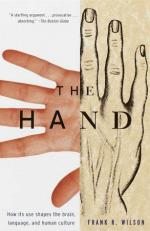
|
| Name: _________________________ | Period: ___________________ |
This test consists of 15 multiple choice questions and 5 short answer questions.
Multiple Choice Questions
1. How many levels does the continuum of communicative movements have?
(a) 1.
(b) 4.
(c) 3.
(d) 6.
2. What is ChomTur?
(a) A rubric for studying brain wave patterns.
(b) The term for specialized control mechanisms of language.
(c) A term for specialized control mechanisms of thought.
(d) A rubric for studying speech patterns.
3. What is one of medicine's oldest links?
(a) Magic and its connection with charismatic persuasion.
(b) Existence of pathogens.
(c) Medicines.
(d) The Hippocratic oath.
4. What is Jack restoring?
(a) A 1956 Chevy.
(b) A 1954 Dodge.
(c) A 1944 Dodge.
(d) A 1949 Mercury.
5. Who coins the term ChomTur?
(a) Frank Wilson.
(b) Noal Chomsky.
(c) Frederick de Saussure.
(d) Michael Chyet.
6. What rule does Greenfield propose?
(a) A hierarchical rule generator.
(b) A rule that illustrates how an adult can sometimes change hand dominence.
(c) A rule that a person uses to decide what skills to develop.
(d) A rule that illustrates how a child can sometimes change hand dominence.
7. What does Feldenkrais facilitate?
(a) Moving without awareness.
(b) Moving through a full range of motion.
(c) Relearning what is not learned.
(d) Learning what one already knows.
8. What is one level of communicative movement?
(a) Lying in a fetal position.
(b) Sitting in a lotus position.
(c) Iconic hand gestures.
(d) Iconic eye movements.
9. What type of intelligence does Patricia Greenfield study?
(a) Coordination intelligence.
(b) Patricia Greenfield studies human intelligence as it unfolds in adult behavior over twenty year.s
(c) Patricia Greenfield studies human intelligence as it unfolds in child behavior twenty years earlier.
(d) Physiological intelligence.
10. What must the magician do for success?
(a) Create an illusion.
(b) Create trust.
(c) Create disillusionment.
(d) Create confidence.
11. What does William Calvin claim about female apes?
(a) They fight more than the males.
(b) They nurture less than the males.
(c) They are often grouped by age.
(d) They are the main hunters.
12. What does Wilson say is an emotional experience?
(a) Food.
(b) Completing a perfect, nine-course meal.
(c) Learning a new skill.
(d) Interacting with an aclaimed chef.
13. What does the Israeli physicist discover?
(a) Quarks move faster when someone thinks about their doing so.
(b) Certain movements can lead a person with practice to move more smoothly and efficiently.
(c) Quarks are not in this dimension.
(d) Some movements are mimicked on the micro level.
14. What did ground mammals eat at this time?
(a) Mostly nuts and grass.
(b) Mostly birds.
(c) Vegetarian matter or carnivores.
(d) Just small rodents.
15. What do Haeckel, Reynolds and Dunbar confirm?
(a) Children become improvisers before they can even talk.
(b) Apes and children have a very different evolutionary process from about six months on.
(c) Children become problem solvers even before they can talk.
(d) Aspects of the evolutionary process perceived in Greenfield's theory.
Short Answer Questions
1. In what way does Yves Guiard propose both hands perform?
2. According to Chomsky, how many brain tasks are required for speaking language?
3. How is the dominant hand theoretically controlled?
4. What can can restore feeling to one who has lost a sense of connection with their body and enable movement again?
5. Who calls the hidden structure of words "innate syntax"?
|
This section contains 519 words (approx. 2 pages at 300 words per page) |

|




